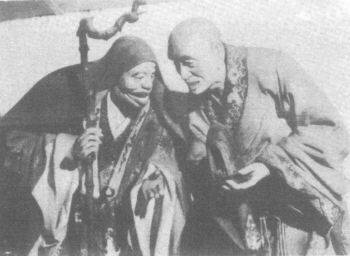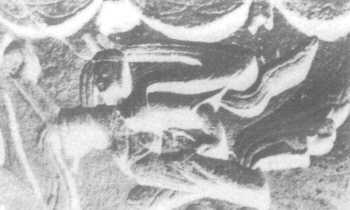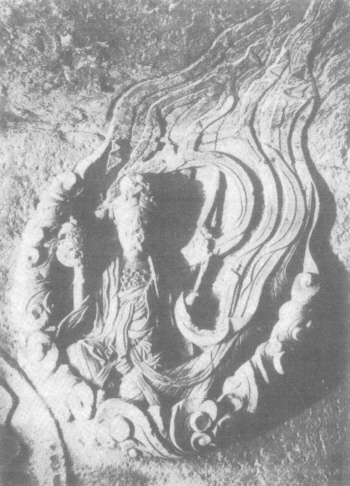Chapter 12 Section 2 The Chineseization of Buddhist Sculpture Figures
The Sinicization of Buddhist sculpture requires idols that are suitable for China's national conditions and the needs of Chinese people.The emergence of this kind of idol is not to recreate it from scratch, but to transform or give new meaning to the Buddhist image from India.Bodhisattva, Arhat, and Feitian are representatives of this image.
Buddha in India, legend has it that there are sacred places such as Vulture Mountain and Sarnath, while in China there are only Bodhisattvas.For example, Mount Putuo in Zhejiang, Mount Wutai in Shanxi, Mount Emei in Sichuan, and Mount Jiuhua in Anhui are the ashrams of the four Bodhisattvas, Avalokitesvara, Manjusri, Samantabhadra, and Ksitigarbha.Bodhisattva worship is a unique phenomenon in Chinese Buddhism.One of the most important phenomena accompanying Bodhisattva worship is the feminization of Bodhisattvas.And the typical example of Bodhisattva worship and feminization of Bodhisattva is Avalokitesvara.The worship of Avalokitesvara originated in the Northern Qi Dynasty and reached its peak in the Tang Dynasty.As the image of saving sentient beings and rescuing sufferings, China has created various Guanyins.Such as Avalokitesvara in White Cloth, Avalokitesvara in Willows, Avalokitesvara in Fish Basket, Avalokitesvara in Lying Lotus, Avalokitesvara in Sending Children and so on.They are all products of Chinese culture.This compound goddess of beauty and loving mother has penetrated into thousands of households.In Song Lian's Praise for the Portrait of Avalokitesvara Bodhisattva in the Ming Dynasty, it was said that "there are nine out of ten rooms who worship his image". It is conceivable that there are so many believers.Among the statues of the Tang Dynasty, whether they are stone carvings, clay sculptures, or gold and bronze statues, the number of Guanyin statues is extremely large.After the Tang Dynasty, the trend of excavating grottoes in China declined day by day, and there were not many stone carvings of Guanyin, and statues of Guanyin generally appeared in porcelain sculptures, tooth carvings, and wood carvings.Guanyin before the Song Dynasty, like other Bodhisattvas, showed more body, and Yingluo (yingluo Yingluo, a string of pearls and jade worn on the body by the middle finger of Buddhism) was solemn and gorgeous.After the Song Dynasty, Avalokitesvara was mostly called Dashi, and they wore robes as their basic attire. These robes are full of flowing beauty and the beauty of lines.Therefore, the Guanyin of these sculptures looks elegant and unrestrained.In the statues of Guanyin, there is a very thought-provoking phenomenon, that is, the treatment of some different-phase Guanyin.For example, Avalokitesvara with Eleven Faces, Avalokitesvara with Six Arms, and Avalokitesvara with Thousand Arms and Thousand Eyes, in Indian or Chinese early Buddhist statues, the number of faces, arms, and hands is often used as the main reflection, and the images created are more than weird and not beautiful. .These Avalokitesvara statues since the Tang Dynasty have carved the real female image as the basic image of Avalokitesvara, and subtly changed the multi-faceted, multi-armed, and multi-handed parts that express mana into decorative parts.Like the eleven faces, they are combined into a coronal body, just like the corolla on the head of Avalokitesvara.Another example is thousands of hands and thousands of eyes, which are combined as the background to form the body light of Guanyin.A famous example is Avalokitesvara with Thousand Arms and Thousand Eyes in the Song Dynasty in Dazu Baoding, Sichuan. More than 1,000 hands like peacocks are placed behind the image of Avalokitesvara on a colored screen, with one eye engraved in each hand, which not only conveys religious teachings, but also receives good art. Effect.This treatment of Avalokitesvara shows that the Chinese place great emphasis on beauty and despise religious teachings between beauty and religious teachings.This actually goes back to the old problem, that is, the rigid depiction that pays more attention to symbolism than its specific details.
Among the Chinese Buddhist sculptures, apart from the female Avalokitesvara, the most Chinese characteristic is the male Arhat.Arhat is Arhat, which is the highest state of practice in Theravada teachings, and one who attains the fruit of Arahant will attain the fruit of Arhat when one's meritorious deeds are completed.To practice Arhatship, one must become a monk; otherwise, one's life will be in danger.If you become a monk, you must shave your hair, so anyone who is called an arhat is bald.After Arhat entered China, there are several theories about his life, name, and number. This kind of uncertainty just provides the possibility for the gallop of artistic imagination.As soon as the arhats entered China, they wore Han-style monk clothes, which in turn connected them with the lives of ordinary Chinese people.Among Tang and Song arhats that survive today, those with high artistic achievements include 25 arhats in the Kanjing Cave of Longmen Grottoes in Luoyang, Henan, 18 arhats in Baosheng Temple in Wuxian County, Jiangsu Province (nine extant bodies), 16 arhats in Zijin Nunnery, and 40 arhats in Lingyan Temple in Changqing County, Shandong Province. arhat.These arhats have well-proportioned proportions, delicate expressions, different appearances, and the pleats of their clothes flow freely, all of which are quite artistic.Once the trend of sculpture arhats started, it was out of control, from 16 arhats to 18 arhats, and then to 500 arhats.Because there are so many Arhats, it is no longer possible to place them beside the Buddha, so we had to build a hall for them, and the Arhat Hall, a form native to China, appeared.Arhat Hall is a man's world, so many men gather together, it is naturally very lively.The naming of the 500 arhats is not strictly regulated, and can be changed according to the situation.This kind of arbitrariness opens the door to more artistic creation.In the statues of Arhats of various generations, we can see such a trend. Except for some strange shapes indicating that they came from outside the region, the earlier ones are generally sitting upright and dignified.Later, the arhats became more and more ordinary, and finally, the arhat hall became a gathering place for various folk customs, and the arhats showed a variety of market customs and appeared lively.There are 500 arhats in Kunming Qiong (Qiong Qiong) Bamboo Temple. The artistic level is extremely high, and it can be regarded as a superior work of clay sculpture. (Figure 21)
Feitian is a very common role in the Buddhist world, but it is just to show that heaven and man offer to Buddha.They flew in the air when the Buddha preached the Dharma, some of them gave off bursts of attacking fragrance, and some made bursts of pleasant voices.It can be said that compared with Buddhas and Bodhisattvas, Feitian is just some auxiliary gods, similar to those who play tricks in Beijing opera, to add to the fun and create the atmosphere.But when these gods came to China, they aroused the passion of Chinese artists.Feitian has become a very plump and vivid artistic image.

Figure 21 Arhat Niqing Qiongzhu Temple in Kunming, Yunnan
China's flying sky can be divided into Yungang Feitian, Maijishan Feitian and Dunhuang Feitian.
Yungang Feitian is a kind of exaggerated deformation, and it is also the process that best reflects the artistic image of Feitian from foreign characteristics to Chinese characteristics.Yungang Northern Wei Feitian can be roughly divided into: short, fat and realistic, mainly in Tanyao Cave 5 and Caves 5 to 10; those whose bodies start to elongate, mainly in Caves 11 to 15; those whose bodies are elongated and stretched out , mainly in the western small niche group after Cave 22.From the short and fat body to the crouching shape, to the elongation of the body, and finally to the stretching of various parts of the body (arms, abdomen, thighs, face, neck, etc.), it is essentially a gradual Chineseization of a foreign image. process.Yungang's flying apsaras are basically carved within a small range, or within different frames, such as semicircles, rhombuses, parallelograms, rectangles, triangles, and irregular polygons.In short, Yungang Feitian is created with the characteristics of filling in the gaps.This kind of creation requires the artist to have a high degree of wisdom and skills.If you think about the traditional Chinese tile art and Xiao Xingyin art since the Middle Zhou Dynasty, Qin Dynasty and Han Dynasty, this kind of creation happens to be the specialty of Chinese artists.The most important creative principle is to arrange the shapes through deformation according to the shape of the picture.From Yungang Feitian, it can be seen that the early short and fat Feitian seldom deformed, and it was not very coordinated with the frame where the Feitian was installed.As time went on, Feitian became more deformed and distorted, and Feitian became more harmonious with the given plane shape, and finally merged with traditional culture to form a smooth and graceful Yungang Feitian, which is a deformed shape composed of body postures. A typical example of the beauty of various curves. (Figure 22)

Figure 22 Feitian Stone Yungang Grottoes in Datong, Shanxi, Northern Wei Dynasty
Maijishan Flying Apsaras mainly shows a sense of floating in a scarf suit.The bodies of these Feitians don't have too much distortion, but usually a part of the loose robes are blown up and blown away by the wind, which can be regarded as a kind of Wei and Jin literati demeanor.However, Maijishan Flying Apsaras uses the form of a towel to float in the wind and wander in the sky, which directly opened up the free style of flying Apsaras in the Tang Dynasty.
The flying apsaras in Dunhuang mainly refer to the flying apsaras of the Tang Dynasty.Of course, these flying apsaras are painted on murals, mostly on wide screens or in spacious places.Therefore, the limbs are stretched and the ribbons are fluttering, showing a rising or falling momentum, quite like a fish in water and a sense of freedom in pitching.Therefore, the Flying Apsaras of the Tang Dynasty in Dunhuang is a stretched and fit type.The Flying Apsaras in Dunhuang are painted, but this artistic image can be found on Tang Dynasty stone carvings in other areas, so it can be seen that there is a common powder copy, and this powder copy may come from the Guanzhong area.For example, the current Bazhong and Tongjiang counties in Sichuan are separated from Hanzhong in Shaanxi by only one mountain (across the Daba Mountain). Because it is "within the threshold" of Chang'an ("Shu Jian").There are many stone carvings in the Tang Dynasty in these two counties, and there are still some caves excavated in the Tang Dynasty, such as the South Shrine, West Shrine, North Shrine, Shuining Temple and Tongjiang Thousand Buddha Cliff in Bazhong.The flying apsaras of these stone carvings are very vivid, just like the flying apsaras of the Tang Dynasty in the murals of the Mogao Grottoes in Dunhuang.In particular, the Flying Apsaras in the No. 103 niche of Bazhong South Shrine is engraved on a cliff more than ten meters high. A flying sky, leaning on a cloud and descending from the sky, the long streamers, like two white strings, made the empty cliff more alive, and also strengthened the sense of movement of the flying sky.This free, comfortable, relaxed, and unrestrained posture is completely a Chinese dancer's free flying in the air, and it is a completely Chinese image. (Figure 23)

Figure 23 Feitian Stone Miaogao Mountain in Dazu, Sichuan, Song Dynasty

Figure 21 Arhat Niqing Qiongzhu Temple in Kunming, Yunnan

Figure 22 Feitian Stone Yungang Grottoes in Datong, Shanxi, Northern Wei Dynasty

Figure 23 Feitian Stone Miaogao Mountain in Dazu, Sichuan, Song Dynasty
